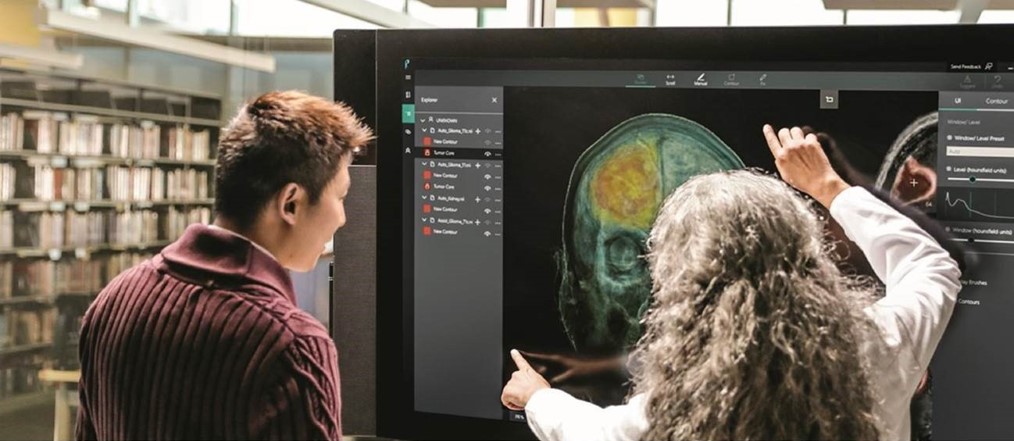
Reimagining healthcare: Partnering for a better future
There has never been a more exciting time to be working in healthcare and life sciences at Microsoft. Our investments across our organization in research and development, world-class talent, and strategic partnerships reflect our CEO Satya Nadella’s vision that many of the next health breakthroughs will come from healthcare and life sciences organizations working in partnership with technology companies like Microsoft. With our partners and our customers, we are just beginning to unlock the power of technology and innovation to advance our shared understanding of human health.
This unique opportunity to make a lasting, positive impact on healthcare is one of the reasons I joined Microsoft. For decades, Microsoft has built a reputation as a trusted partner, now counting more than 168,000 healthcare organizations around the world who rely on us. As we’ve built out platforms for cloud infrastructure, productivity and collaboration, and artificial intelligence, we’ve developed an ecosystem of hundreds of thousands of partners who are building on our technologies and bringing added value to our mutual customers.
Innovation in medical imaging
Being new to Microsoft and a neuroradiologist, one of the areas I am most excited about is how we are helping our customers and partners reimagine healthcare and specifically explore the possibilities in medical imaging. In this area that is so critical to healthcare overall, we’re fortunate to work with some of the leaders in the industry.
GE Healthcare customers in the United States can take advantage of solutions running on Microsoft Azure such as the newly developed Edison™ Datalogue™ Connect, which was designed to provide secure image and data exchange to physicians working in their care settings.
Philips’ Azurion image-guided therapy platform empowers providers through image-guided minimally invasive therapies. Built for HoloLens 2, the work-in-progress Azurion mixed reality platform brings live imaging and other sources of vital data — currently displayed on large external 2D screens — into a 3D holographic environment that can be controlled by the physician.
Nuance, a leader in radiology reporting solutions with its PowerScribe platform, continues to lead the way in bringing ambient technologies to healthcare. We recently announced a strategic partnership with Nuance to accelerate that innovation, bringing together Nuance’s healthcare-optimized AI powered clinical documentation and decision support solutions and Microsoft Azure, advanced conversational AI, and natural language understanding.
Working together with researchers and industry partners, we’re also moving forward to create a broad range of cloud-based tools and solutions that touch many aspects of the development and delivery of effective care, including:
- Azure Quantum solutions at work with Case Western Reserve University to accelerate and improve the accuracy of MRI scanners.
- New opportunities to accelerate medical imagining with GraphCore and the Intelligence Processing Unit (IPU).
- Empowering health team collaboration with Microsoft 365. Intelligent meetings and modern collaboration in a secure platform that integrates with clinical systems, from electronic health records to imaging software.
- Research projects in registration and segmentation. Two of the fundamental problems that clinical researchers and practitioners are dealing with when working with 3D medical imaging modalities.
- The Azure Stack Edge, a new Azure-managed appliance that brings the compute, storage, and intelligence of Azure to the edge for new healthcare scenarios including hardware acceleration with FPGA and GPU.
As part of our ongoing commitment to making health data easier to manage, in October we announced the general availability of the Azure API for FHIR. FHIR is quickly becoming the preferred standard for exchanging electronic health information and enabling the management of PHI data in the cloud. A rapidly growing number of healthcare delivery and healthcare technology companies are already using the Azure API for FHIR to improve interoperability within their own IT systems, including Great Ormond Street Hospital (GOSH) of the NHS, Darena Solutions, Northwell Health, and Humana. With the release of the Azure API for FHIR, Microsoft now provides a fully managed, enterprise-grade service for health data in the FHIR format. Building on this announcement, a few weeks ago we announced the IoMT FHIR Connector for Azure – an open-source tool enabling our customers to more easily ingest data from health and medical devices, including a FHIR framework for Apple HealthKit.
This investment in innovation with our partners and customers puts us on a path to make a meaningful impact in medical imaging. Together we can empower providers with an enterprise imaging platform that enables reliability and security, manages growing patient data with strong controls for privacy and compliance, and provides insights from the data to improve patient care.
[msce_cta layout=”link_only” align=”center” linktype=”blue” linkurl=”https://rsna2019.mapyourshow.com/8_0/exhibitor/exhibitor-details.cfm?exhid=00467889″ linkscreenreadertext=”Connect with us at RSNA” linktext=”Connect with us at RSNA” ][/msce_cta]
Learn more at RSNA
We will be engaging with more than 50,000 clinicians in radiology at the Radiological Society of North America (RSNA) conference in Chicago. Stop by our Microsoft Booth #10745 in the AI Showcase to learn more about our work and see how we are collaborating with partners and customers to reimagine healthcare. Our partners: Agfa HealthCare, Lunit, NucleusHealth, RamSoft, SOPHiA GENETICS, Volpara, 7 Medical and others will be on hand to share their innovative work. In a special session, I’ll be sharing Microsoft’s view on the opportunities to reimagine healthcare and specifically medical imaging. Several of our partners will join to share how they’re using technology, from the cloud to quantum computing to mixed reality and teleradiology, to help radiologists today.




